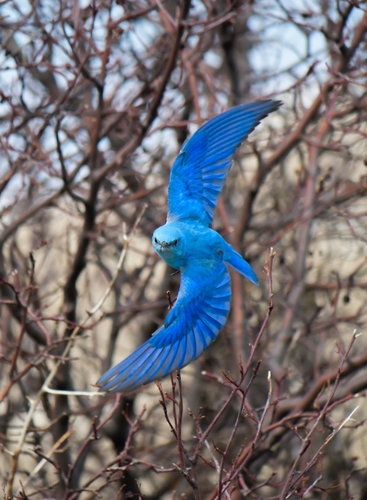
Mountain Bluebird
The Mountain Bluebird (Sialia currucoides) is a striking, medium-sized thrush renowned for the brilliant azure blue plumage of the males. These birds are primarily found in open, mountainous regions of western North America. They play a vital ecological role as insectivores, helping to control insect populations, and also contribute to seed dispersal. Mountain Bluebirds are cavity nesters, often relying on pre-existing holes in trees or nest boxes provided by humans. They are not typically associated with any specific cultural significance beyond their general appreciation as symbols of happiness and spring.
16-20 cm
Length
28-36 cm
Wingspan
Least Concern
Conservation Status
Distribution
Mountain Bluebirds are primarily found in western North America, ranging from Alaska and central Canada south to central Mexico. Their breeding range extends eastward to the western Great Plains. During winter, they migrate southward, with some populations remaining as far north as southern British Columbia and others reaching central Mexico. Their altitudinal range extends from sea level in some areas to over 3,500 meters (11,500 feet) in mountainous regions.
Lifespan
Up to 10 years in the wild, with a mean of 6 years.
Mountain Bluebird's Habitat
Habitat Types
Open woodlands, Mountain meadows, Grasslands, Sagebrush steppe, Burned forests
Climate Zones
Temperate, Boreal, Subalpine
Adaptations
Mountain Bluebirds are well-adapted to open habitats, with strong flight capabilities for catching insects in mid-air. Their preference for cavity nesting provides protection from predators and harsh weather.
Variations
No subspecies are currently described.
Appearance
Breeding Plumage
Males are a brilliant sky-blue above and pale below during the breeding season. Females are duller, with grayish-brown upperparts and blue tinges on the wings and tail. Non-breeding plumage is similar, but the colors may be slightly less intense.
Seasonal Feather Changes
Some fading may occur after the breeding season
Sex Based Plumage Differences
Significant. Males are much brighter blue than females.
Notable Features
Bright blue plumage (males), Relatively long wings, Slender bill
Diet and Feeding
Primary Foods
Insects, Spiders, Berries, Small fruits
Foraging Behavior
Mountain Bluebirds often hunt by hovering above the ground and dropping down to capture prey. They also perch on elevated positions and fly out to catch insects in mid-air (hawking). They will consume berries and small fruits, particularly during the winter months.
Specializations
Their relatively long wings and agile flight are adaptations for catching insects in the air.
Seasonal Diet Variations
Their diet shifts significantly between seasons. During the breeding season, they primarily consume insects. In winter, they rely more on berries and fruits when insects are scarce.
Behavior
Social Structure
Mountain Bluebirds are generally territorial during the breeding season, defending their nesting site. Outside of the breeding season, they may form small flocks, sometimes mixed with other species.
Communication
Soft, warbling songs, Chattering calls, Wing-waving displays
Migration
Many Mountain Bluebird populations are migratory, moving south for the winter. The extent of migration varies, with some populations being resident year-round. Migration is triggered by food availability and weather conditions.
Territorial or Group Behaviors
They defend their nesting territories vigorously against other bluebirds and other cavity-nesting species. Outside of breeding, they are more tolerant of other birds.
Conservation
Threats
Habitat loss (due to logging, development), Competition with non-native species (e.g., European Starlings, House Sparrows) for nest cavities, Pesticide use (reducing insect prey), Climate change (altering habitat and food availability)
Protection Programs
Nest box programs (providing artificial nesting cavities), Habitat restoration efforts, Monitoring of populations
Local National Laws
Protected under the Migratory Bird Treaty Act in the United States and Canada.
Population Trend
Stable
Population Estimates
Approximately 8 million.
Interesting Facts
They can hover like a hummingbird.
This allows them to catch insects in mid-air and inspect potential nest cavities.
Mountain Bluebirds are one of only three bluebird species found in North America.
The others are the Eastern Bluebird and the Western Bluebird.
The male's bright blue color is not due to pigment, but to the structure of the feathers.
Microscopic structures in the feathers scatter light, creating the blue appearance.
Faqs about Mountain Bluebird
What can I do to attract Mountain Bluebirds to my yard?
Provide open habitat, install nest boxes, and avoid using pesticides.
Do Mountain Bluebirds reuse their nests?
They may reuse a nest site, but typically build a new nest each year, often on top of the old one.
How can I tell the difference between a male and female Mountain Bluebird?
Males are a bright, vibrant blue, while females are much duller, with grayish-brown upperparts and blue tinges on the wings and tail.
Copyright @ Nature Style Limited. All Rights Reserved.
 English
English